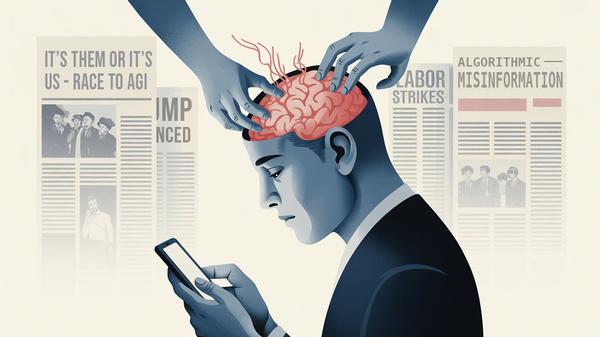

We're building the most invasive surveillance apparatus that history has ever known, and we're deploying it at a rate that's unprecedented in human history.

Democracy Under Digital Siege — A Warning
Technology poses an existential threat to democracy through a slow-motion digital coup that consolidates power in the hands of tech giants.

In 2019, journalist Carole Cadwalladr stood before a TED audience and delivered a warning that would cost her dearly. Technology, she cautioned, had become a threat to democracy itself. For her efforts, she faced ruinous litigation that nearly ended her career. Four years later, her warnings appear not merely prescient but understated. What we're experiencing isn't simply technological disruption but what Cadwalladr aptly termed a "coup"—executed not with tanks in the streets but with servers in the cloud.
Unlike traditional power seizures, this transformation unfolds in slow motion, visible primarily through its effects: disintegrating social consensus, algorithmic manipulation of public opinion, and the quiet consolidation of informational control within a handful of corporate entities. The crisis represents something more profound than another chapter in the digital revolution—it signals a fundamental restructuring of social power that merges corporate surveillance with elements of state authoritarianism.
Historical Echoes in Technology and Power

Radio's Revolution: Lessons from 20th Century Mass Media
To understand the magnitude of this shift, historical precedent offers illumination. In the early 20th century, radio technology followed a similar trajectory—beginning as a democratizing force before becoming a powerful tool for mass influence. The Nazi regime's distribution of affordable Volksempfänger ("people's receivers") and the Soviet Union's Radio Moscow broadcasts demonstrated how new communication technologies could shape national consciousness at unprecedented scale.
Today's digital platforms and AI systems represent a quantum leap beyond these capabilities. They offer not just mass communication but personalized influence, tailored to individual psychological profiles and delivered with algorithmic precision. The internet's evolution from a decentralized academic network to a corporate-controlled surveillance apparatus follows recognizable patterns of technological capture. Just as industrial monopolies of the 1800s leveraged railroad infrastructure to dominate commerce, today's tech giants have transformed digital infrastructure into systems for controlling information flows and, increasingly, human behavior itself.
The Invisible Architecture in Systems of Control

The architecture supporting this transformation operates largely unseen but rests on three interconnected technological systems: comprehensive data collection, algorithmic processing, and behavioral modification. Each represents a remarkable achievement in human innovation that, without democratic oversight, functions as a mechanism of control rather than liberation.
Ubiquitous Surveillance: The Data Collection Apparatus
The first layer—data collection—extends far beyond the information we consciously share. Ubiquitous sensors in smartphones and IoT devices track location and activity patterns. Sophisticated browser fingerprinting techniques identify users across platforms. Financial transactions create detailed consumption profiles. Biometric systems capture physical characteristics, while relationship mapping algorithms construct social graphs that predict influence patterns and personal connections.
Algorithmic Processing: Prediction and Pattern Recognition
This collected data feeds the second layer—algorithmic processing—where machine learning systems analyze patterns to predict behavior with increasing accuracy. Content recommendation engines shape information exposure based on engagement likelihood rather than informational value. Sentiment analysis tools monitor public mood, while pattern recognition systems identify emerging dissent. Perhaps most concerning, deep learning models now generate synthetic media indistinguishable from authentic content.
Behavioral Engineering: From Influence to Manipulation
The third layer—behavioral modification—applies these insights to shape human action. Micro-targeted advertising delivers precisely calibrated persuasive messages. Engagement is gamified to maximize platform usage. Content promotion and suppression algorithms shape public discourse. The most advanced systems enable real-time response manipulation, subtly guiding users toward predetermined outcomes without their awareness.
Digital Territory: The New Geography of Cloud Infrastructure
Supporting this entire apparatus —and forming what amounts to digital territory— is cloud infrastructure that represents a new form of territorial control. Three American companies—Amazon, Microsoft, and Google—now control most of the world's cloud computing resources. This centralization creates what Cadwalladr terms "proligarchy"—a fusion of platform monopolies with traditional power structures that concentrates both economic and political influence.
Beyond Capitalism—The New Economy

Surveillance Capitalism: Monetizing Prediction
The economic model driving this transformation operates through mechanisms more subtle than traditional capitalism. Harvard professor Shoshana Zuboff describes it as "surveillance capitalism"—a system that monetizes not just attention but prediction of future behavior. This model extracts "behavioral surplus" from users who simultaneously function as both product and consumer, creating a form of economic exploitation without historical parallel.
Yet this framing itself contains tensions. The very platforms criticized for exploitation also enable unprecedented connectivity, entrepreneurship, and access to information. This paradox—that the same systems simultaneously liberate and constrain—complicates straightforward narratives of technological determinism.
The system operates by monetizing not just attention but emotion, designing interfaces that trigger dopamine responses to maximize engagement. It transforms personal information—once considered private by social consensus—into corporate assets traded on data markets.
Digital Feudalism: Platform Lords and Data Serfs
The resulting arrangement increasingly resembles digital sharecropping, where users generate value harvested almost entirely by platform owners. Network effects further concentrate this wealth. Each additional user increases platform value exponentially while creating higher barriers to competitive entry. The resulting economic structure bears closer resemblance to feudalism than free-market capitalism, with tech platforms functioning as digital lords collecting "data rents" from billions of digital serfs who have few practical alternatives.
Paradox of Connection: Liberation and Constraint
This analysis requires nuance, however. The same technologies enabling these troubling power dynamics have simultaneously created unprecedented opportunities for connection, learning, and coordination. Millions access education that was previously unavailable, find communities across vast distances, and organize for social change using these very tools. The challenge lies not in rejecting technological advancement wholesale, but in reclaiming its development trajectory toward more democratic ends.
The Psychology of Digital Control

Exploiting Vulnerability: Design for Addiction
These economic systems operate alongside equally sophisticated psychological mechanisms. Modern platforms don't simply serve content—they methodically exploit well-documented psychological vulnerabilities. Interface designs create dopamine-driven feedback loops through variable reward patterns identical to those used in gambling machines. Social validation mechanisms trigger tribal belonging instincts through likes and shares. Fear-based content receives algorithmic preference because it drives stronger engagement. Identity-reinforcing recommendations create echo chambers that harden existing beliefs. Meanwhile, the constant stream of notifications induces cognitive overload and decision fatigue that impairs critical thinking.
These systems have evolved beyond mere observation into sophisticated tools for behavior shaping. The combination of AI prediction models with psychological manipulation techniques creates unprecedented power to influence human decision-making at scale. Engineers apply A/B testing methodologies to continuously refine these influence mechanisms, optimizing not for user welfare but for measurable engagement metrics tied directly to corporate revenue.
Reality Fragmentation: The Dissolution of Shared Truth
Perhaps most concerning is the resulting fragmentation of shared reality—a crisis deeper than conventional misinformation. AI-generated content combined with algorithmic filtering creates personalized information environments—what some researchers call "reality tunnels"—that make democratic discourse increasingly difficult. This fragmentation operates through multiple mechanisms: it erodes common ground for political dialogue; amplifies existing social divisions through content recommendation systems; creates self-reinforcing belief systems resistant to contradictory evidence; undermines institutional trust; and facilitates mass manipulation through competing narrative structures.
The New Cold War’s Digital Battlefield

Competing Models: Techno-Authoritarianism vs. Surveillance Capitalism
These developments have profound global implications, creating new international tensions that transcend traditional geopolitical boundaries. In essence, what we're witnessing amounts to is a new Cold War—not primarily over territory or ideology but over digital control and information dominance. China's techno-authoritarian model, exemplified by systems like social credit scoring and pervasive monitoring, competes with Silicon Valley's surveillance capitalism for global influence. Meanwhile, Russian information operations exploit vulnerabilities in both systems, demonstrating how digital infrastructure weaknesses become national security threats.
Digital Proxy Wars: Information Operations and Sovereignty
This competition manifests through digital proxy wars conducted via sophisticated information operations; accelerating competition for AI supremacy; increasingly complex battles over data sovereignty; cyber-physical hybrid conflicts that blend digital attacks with real-world consequences; and emerging forms of digital colonialism where powerful technology exporters shape the development trajectories of technology-importing nations.
Democracy's Vulnerability: The Challenge to Self-Governance
Democratic systems face particular vulnerability in this environment given their reliance on informed public discourse. They must navigate seemingly impossible tensions between security imperatives and privacy protections; develop regulatory frameworks for global platforms that transcend jurisdictional boundaries; counter sophisticated information warfare without undermining free expression; maintain institutional legitimacy against algorithmic undermining of trust; and address unprecedented concentrations of corporate power while remaining attractive to innovation.
This challenge is further complicated by the unevenly distributed nature of both digital harms and benefits. Marginalized communities often experience the surveillance aspects of these technologies most acutely while having less access to their advantages, creating digital equity questions that extend beyond simple access to encompass questions of design, governance, and impact.
Reclaiming Digital Democracy Through Collective Action

Individual Protections: Personal Digital Security
Effective responses to these challenges must operate across multiple domains simultaneously. Technical solutions require both individual protection measures and systemic reforms. At the individual level, adopting end-to-end encryption, practicing data minimization, implementing digital security protocols, exploring alternative platforms, and utilizing privacy-enhancing technologies can reduce personal vulnerability.
Systemic Reform: Rebuilding Digital Infrastructure
However, individual action alone proves insufficient without corresponding systemic changes: developing decentralized infrastructure that resists centralized control; creating viable open-source alternatives to corporate platforms; implementing privacy-by-design protocols that protect users by default; building algorithmic transparency tools that expose manipulation; and designing democratic technology governance models that ensure public oversight of critical systems.
Policy Frameworks: Regulation for the Digital Age
These technical approaches must be complemented by comprehensive policy frameworks. Effective regulation needs to address fundamental questions about data protection and ownership rights; create meaningful algorithm accountability mechanisms; establish appropriate platform liability for foreseeable harms; implement competition policies that prevent digital monopolization; and ensure democratic oversight of AI development trajectories.
Collective Action: Beyond Consumer Choice
Perhaps most importantly, these challenges require collective action beyond individual consumer choices. Digital rights organizations play crucial roles in advocacy and awareness. Technology worker organizing creates internal pressure for ethical practices. Consumer privacy movements build market demand for better alternatives. Community-supported democratic technology initiatives demonstrate viable alternatives. International coordination prevents regulatory arbitrage by powerful actors.
The Power and Possibility of Power

The Beautiful Internet: Necessity, Not Luxury
The path toward what Cadwalladr calls the "beautiful internet of the future" requires fundamental restructuring of digital power relationships. This restructuring must begin by reestablishing democratic control over technologies that increasingly shape public life. Public oversight of critical digital infrastructure, democratic governance of AI development trajectories, community ownership models for data resources, and robust algorithmic accountability mechanisms represent starting points for this transformation.
Simultaneously, we must build alternative systems that demonstrate viable paths forward: decentralized social platforms that resist monopolistic control; privacy-preserving technologies that protect rather than exploit users; democratically developed AI systems aligned with public rather than shareholder interests; and community-owned digital infrastructure that serves local needs while connecting globally.
These alternatives can inform new frameworks necessary for long-term solutions: comprehensive digital human rights standards that extend existing human rights into digital contexts; international data protection agreements that prevent exploitation across jurisdictional boundaries; democratic technology governance models that ensure public input into consequential decisions; and ethical AI development principles that prioritize human flourishing over narrow optimization metrics.
Privacy as Power: The Foundation of Democracy
We stand at what Cadwalladr correctly identifies as a decisive inflection point in technological history. The infrastructure of digital authoritarianism is being assembled piece by piece, often with the willing participation of those who initially built the internet with democratizing intentions. This trajectory, however, is not inevitable.
The same technologies currently enabling surveillance and control contain within them the potential for redesign—to protect rather than violate privacy, to enhance rather than undermine democratic participation, to connect rather than divide communities. The fundamental question isn't whether technology will shape our future—that much is certain—but whether that future will remain meaningfully under human direction and democratic influence.
The "beautiful internet of the future" that Cadwalladr envisions represents not merely an idealistic aspiration but a practical necessity for democratic survival. Achieving it requires recognizing that privacy is not simply about personal security or convenience—it's fundamentally about power. When we surrender privacy, we surrender autonomy. When we surrender autonomy collectively, we surrender democracy itself. The protection of individual privacy has become inseparable from the preservation of democratic self-governance, making this perhaps the defining political challenge of the digital age.
Courtesy of your friendly neighborhood,
🌶️ Khayyam

Don't miss the weekly roundup of articles and videos from the week in the form of these Pearls of Wisdom. Click to listen in and learn about tomorrow, today.

Sign up now to read the post and get access to the full library of posts for subscribers only.

This analysis reflects on the transformative impact of technology on power structures, drawing from recent discussions, expert insights, and the increasing realization that our digital landscape is reshaping the very foundations of democracy. That, and I just watched Carole on the YouTube with her TED Talk.










Member discussion